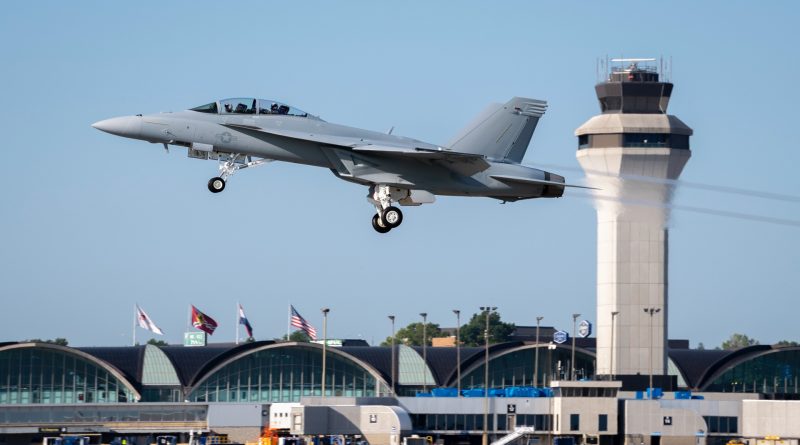F/A-18 Super Hornet Simulator Trial
During the media day organized by Boeing in Saint-Louis, I was granted with a demonstration of the Super Hornet in a simulator. Here is the summary and my impressions of this too brief session.
The Installations
The flight simulators of Boeing’s fighter jets in Saint-Louis are grouped together at the integration and training centre. In this building, it is strictly forbidden to carry a cell phone or even a smart watch. Guests and employees should leave their devices in a locker before accessing them.
In addition to pilot training, this centre is also used for the development and integration of new systems. Any new software, type of weapon or modification to the programming is validated here. The integration centre is currently working on systems that will be implemented over the next ten years. Checks and modifications are not limited to programming. The ergonomics and usefulness of the new systems are rigorously evaluated.
The centre groups together several training devices ranging from the simplest to the most complex. The most realistic simulators are installed under a large dome that serves as a projection screen. In Saint-Louis, there are therefore three domes, each containing a motionless simulator.
Flying the F/A-18 Super Hornet
Most pilots started their training on Cessna 150 and they’ll tell you the cockpit is tiny. This is an opinion I shared until I embarked on that of a Super Hornet. The throttle levers and the joystick are only 12 inches (31 cm) apart. In between is the left knee which is almost in the way. The advantage of a small cockpit is that it is ergonomic, everything is so close. Note that in a maneuver over 5G it’s a good thing not to have to stretch your arms.
The effectiveness of the Super Hornet’s flight controls increases exponentially with the amplitude of displacement. It is therefore very easy to make small corrections and a full deflection of the controls results in a sharp and rapid reaction. At over 400 knots, the barrel roll is done very quickly. In fact, the flight controls are very well designed, and I got used to them in less than two minutes.
Even in static, it’s still nice to make a 70-degree bank turn at over 500 knots. In fact, it’s probably harder to take it on a real flight because of the G’s.
The Magic of the Heads up Display
Performing a visual flight landing comes down to coordination between the pilot’s eyes and its hands. In fact, there is a very simple rule of thumb that applies to many situations: Your hands will always lead you to where your gaze is. During a landing, the pilot fixes the place where he wants to land. Likewise, the truck driver must fix the place where he wants to back his trailer and not back of it. To avoid an obstacle, the driver of a car must fix the place where he wants to go and not the obstacle.
But the landing maneuver requires a lot of care, as there are several parameters to consider as well. The pilot’s eyes are therefore called upon to look regularly on the dashboard. This is a temporary distraction that reduces the effectiveness of hand-eye coordination. The head-up display projects necessary information into the pilot’s field of vision during a maneuver. All the information is there without having to move the eyes focus.
On the Super Hornet, the heads up displays show a small circle with a bar on each side (the flight director). For the landing, it is enough to place the flight director on the bridge so that the aircraft goes to the right place. An indicator bar lets you know if you need to adjust the speed. I did two landing maneuvers on a carrier deck and thanks to the head-up display it turned out to be pretty easy. There were three of us doing these maneuvers and we all succeeded despite our inexperience.
For my part, I’ve tried the heads up display a few times in different aircraft: it is such a good feature and it shouldn’t be optional anymore, because, in my opinion, it greatly improves safety.
A good aircraft to fly
During landing maneuvers, the target speed is 135 knots, which is very low for a fighter jet. In this setup, The Supe Hornet is nose heavy and you have to constantly apply light back pressure to maintain the trajectory. But for the rest, it is so easy to fly it that it is disarming. I have no doubt that in the past, landing on a carrier was very difficult to master. But nowadays, technology has come to reduce the risk involved.
>>> Follow us on Facebook and Twitter

